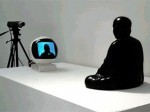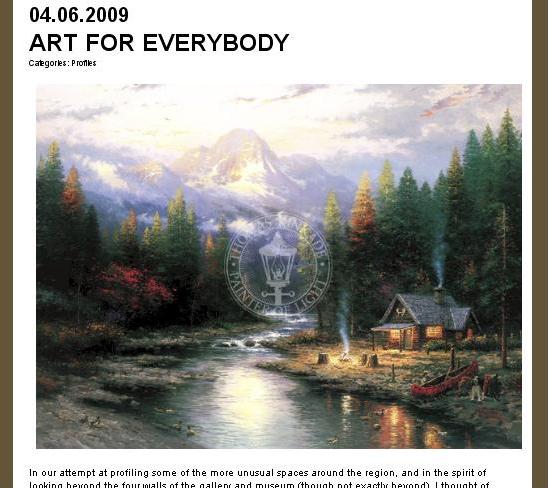


Folks, what you see above is a picture I took with a dinky camera that chose to die on me before I caught a clear shot. My apologies for its awful graininess, but if you will bare with me for a short while, I want to share with you some observations I made that was very personally enriching.

Nam Jun Paik, TV Buddha, 1974
So almost a month back, I came back from work late one evening and said hi to my widowed mother. She was the TV Buddha as usual. I smile the best I can as I entered the house and headed straight to the kitchen to scavenge for dinner. Along the way, I saw by the stairway were the paper crafted treasure boxes for the coming Ching Ming festival. So, this Sunday my family is going to visit my father’s grave for the third time since his death in late December 2007. Cancer. How old was he? I can’t remember. I do not want to remember? My mind snapped back to the paper boxes. They are care packages you send to the beyond. Imagine if you were working or studying overseas and your family sent you courier boxes loaded with local goodies. How did you feel when you received them? Or when you didn’t? So apply that emotion and concept onto the dead and you will understand what these boxes are for. It’s a ritual performed by the living to the dead. ‘Chinese’ people love burning stuff up you know? We burn , and burn, and burn, and burn, oh we love to burn stuff and look at flames. It’s so cave man. In normal daily prayers for the dead, we burn incense, and offer token food. On big occasions like anniversaries and important dates like Ching Ming and the Hungry Ghost Festival, we burn paper prayers and paper treasures and necessities of life in the beyond. Anything you find in a mall, the dead could use it to according to the mind of the more superstitious Chinese.
So this box was part of the five my mother had bought at the market. She is the ritual master for all this traditional prayer things. I don’t believe in it but I do it. It’s a family thing. It’s meaningful for the family. So what did this box mean to me? When I saw the image on the cover of these boxes, I became so excited that I knew I just had to take a picture of it. Normally I let so many images wash away in my head like a heavy rain but this was one was something I had to capture and ponder on further. When Simon introduced an article on Thomas Kinkade about a week later that featured an image that was eerily similar in composition, I knew this was something I should share with people instead of just mauling it in my own mind.

The landscape of these paper crafted treasure box was confounding me on many levels because of its twisted beauty. Its picturesque scene should not distract us from the fact that the packages originates from sacrificial rituals that can be traced all the way to the time actual treasures and real human offerings where buried with dead tribal chiefs. As such, these boxes could also be interpreted as a kind of crude timecapsule. The yellow strip of paper with Chinese markings on it are for me a reminder of how the invention of words and numbers facilitated the trading process. What it says exactly I have no idea as I am practically illiterate in Chinese. I am sure thought that each box has the name of my deceased grandfather, grandmother, 2nd grandmother, father, and uncle on them. The address, I suspect, is the Disney coloured landscape picture. Maybe father is having a blast with Snow White. Or he may want to go out and have a hunt, or ride a canoe, or just take a nap outdoors, who knows? At least he is finally out of the mad city in this vision.
The landscape signifies paradise, but the river is a reminder that there’s still a journey the dead must take to go past hell. Everyone passes through hell according to ancient Chinese customs. These boxes and the packets and packets of paper hell notes burnt are meant to meet the needs of the souls taking that long journey. It might even be used to bribe officials who can shorten their penitentiary period and quicken their path to reincarnation. The cycle of birth and death goes on until goal a form of transcendence, or a state of Nirvana is reach. Perhaps this is long arduous process is represented by the presence of the rocky mountains in the background. It is said that it is possible to sense the presence of the reincarnated soul through the appearance of insects at the funeral. I think I had that experience. Later was a dream where father was basically waving me away. Everything is ok. But that doesn’t mean you stop burning stuff to the dead. There are no gaurantees in life and in death.
It is a puzzle to me why the style of the landscape featured on the cover of the treasure boxes is nothing like what you would expect in a traditional Chinese ink painting. It is actually more similar to the romantic American landscape artists who made many oil paintings of the forests and the rocky mountains in the West Coast during the 18th and 19th century. The respect for perspective and panoramic constructions, the desire for a nature conditioned for a rustic lifestyle, and the love of golden reds to mark changing sunlight and seasons, are typical features of the landscape painting of that era. Such a picturesque scenery were very common and fashionable in America like the way coconut tree and seaside watercolours are typical here. Their popularity suffered a dip in the 20th century as modernization arrived but when abstract paintings finally lost steam, the artists who preserved the 19th century tradition like Thomas Kinkade made a profitable sweep all over America and across the world for many people were starving for something simply nice and pretty for their kitchen wall. Damn the shapes, lines and colours. We want mountains, we want water, we want forests, we want flowers, and most of all, we want the cosy little cottage where all our love resides.
It should be pointed out that the landscape is not a typical image that adorns these paper boxes. More common are simple shapes and motifs which I assume imitates the carvings and decorations of real antique chests. So how did my mother end up with these boxes featuring such American kitsch?
 Chinese Gold Mining in California
Chinese Gold Mining in California
I’m certain it was not the influence of Thomas Kinkade on local funeral papercraftsmen. Something more powerful must be at work here. My wild hypothesis is that such landscapes were souvenirs of Chinese migrants who had traveled and seen America during the late 18th – 19th century gold rush era. Maybe those few who were successful and returned home bought back such idealized pictures of America and those works subsequently influenced the taste of Chinese craftsmen. These are just some fun guesses folks. For the dead, it is a simple image of eternal peace and happiness; to the living, it is a complex negotiation between fantasy and reality. That is just something what we, the living have to deal with all the time.
After the prayer rituals, the treasure boxes were burnt. It’s been 3 weeks now. I wonder how long it takes for something to reach eternity.
Video of a 2007 Hungry Ghost Festival. Another occasion besides Ching Ming to burn stuff for the dead. ~ (DC)
Sorry, the comment form is closed at this time.
great essay Daniel. Really enjoyed reading it.
Personally the Hungry Ghost festival is my favourite season around town, though I wasn’t brought up to practice Chinese folk religion in any way :/
yes it’s a bit excessive but i love the spectacle and the kind of belief in the afterlife that is so much more colourful and complex than the ones I experienced under my catholic upbringing. after all, dancing stage girls a great bon fire at the end of it all, sounds all very rooted to the cycles of living to me.
– simon
Loved this post.
I like the image of them getting care packages… and how they would feel upon receiving them.
Nothing fascinates me more than the paper goodies we burn for the dead. When my grandfather died, he got a big bungalow, a Mercedes (with driver), handphones, piles of expensive shirts and… get this… two servants! With names! The paper Mercedes had a four-digit number plate – you were supposed to go buy Magnum 4D lottery with that.
But it wasn’t only profane – his family had to burn small pieces of white prayer paper… one by one… then the ashes would be squashed into a big flower pot, which would be buried with him. That pot was so damn big. So you just had to sit there burning the paper until the cows came home. Devotion.
At least you don’t bury your wives and concubines with you anymore.
My folks go to get all this paper stuff from a place in Old PJ… I know it sounds morbid, but I have fantasized from time to time about how it would be to work as someone crafting these paper effigies for the dead.
For my death I hope people burn replicas of all those Malaysian pioneer paintings I’ll never get to own in my lifetime.
For my death I hope people burn all those Malaysian pioneer paintings I never get….
jolly goodness! who do you mean exactly, vincent??? :P
Kinkade’s christian paintings + paper crafted treasure boxes = Jade Emperor = Yahweh = Michael Jackson
Damn good at maths yo.
I think they should burn all of kinkades paintings for daniel’s funeral.